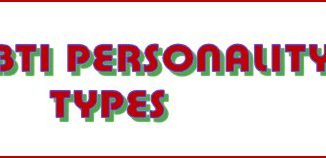
According to at least one psychologist, it is!
Well it has happened again. Another psychologist has gained some media attention by teeing off on the MBTI.
Ever since the MBTI started getting used by corporations forty years ago it has had a target on its back for pot shots from the orthodox psychology community. The most recent cannon shot was launched by Art Markham, writing in Fast Company magazine. Markham is a Professor of Psychology and Marketing at the University of Texas at Austin.
Chagrined that the MBTI and Myers-Briggs personality typology is still quite popular in some circles of social media and in some business settings, Markham hopes to convince companies to stop using these tools in their company settings. He’d also like to convince publications like Fast Company to ban articles that suggest the MBTI and Myers-Briggs has some utility.
Markham’s criticisms follow the play book that MBTI critics have used for over fifty years. They categorize it as a traditional personality inventory and judge it by traditional psychometric standards used for psychological tests and inventories. Numerous mistakes are made in attacking what turns out to be a straw man, among them are:
- They ignore the fact that Isabel called her assessment an “Indicator” – its’ name is Myers Briggs Type Indicator not Myers Briggs Type Inventory. Briggs believed that the results of the Indicator only “suggest” a particular personality type. She believed that it is the individual himself or herself who, after learning about personality typology, will be the best judge of their personality type.
- Myers purposefully created a non-psychometric scoring system. As an Indicator, not a conventional psychological test, Myers created a non-traditional and unique method of scoring the Indicator. She did this so it would NOT be judged by conventional psychometric standards. She did not want scores on the Indicator purport to measure the strength of the eight factors signified by the four letters of the MBTI code.
For example, she did not want a score of 30 on the Feeling dimension to be interpreted as ten times higher than a score of 3. Nor did she want people concluding that a score of 30 on Feeling meant that person had a stronger Feeling nature than a person with a score of 3. Such a score differential is interpreted by a professional user of the MBTI to signify only that those with a score of 30 are more likely clearer that they prefer Feeling over Thinking than the person whose score was 3. Clearly favoring Feeling does not imply expertise. It does not mean one is particularly expert in using one’s Feeling nature.
So psychologists like Markham have used measurement yardsticks to assess the MBTI that fail to recognize its measurement system is in a different language. These critiques do not understand the purpose of the assessment. Perhaps they have been mislead because there have been many research studies using the MBTI and Myers herself (and successor publishers of the instrument) did use some conventional psychometric tools in developing and refining the assessment.
However I don’t want to get into the weeds arguing about psychometrics and test validity. That discussion obscures the most essential distinction that accounts for the success of the MBTI.
A Fundamental Difference in How we Understand Personality
Markham mentions, as others have, the alleged superiority of the Big Five Personality inventories in measuring personality characteristics. The Big Five (and most other personality inventories favored by the mainstream academic psychology community) is based on the tenets of a different “religious” sect than Myers-Briggs. These psychologists believe the best way to understand personality differences is to look at the strength of various traits a person may possess. They look at and examine the individual pieces of a personality and construct an individual’s identity based on the measurement of the degree of strength of these personality pieces.
This branch of personality psychology and what is normal personality development is heavily influenced by the theories and professional focus of the clinical psychologist and psychiatrist. Their focus is on abnormality. Using their tools we all can be described in terms of how unwell or well we might be on various measures. For example the Big Five measures the following five characteristics: Openness to experience, Conscientiousness, Extraversion, Agreeableness, and Neuroticism. The first four are wellness measures. Scoring high on them is good, scoring low on them is not so good and not a good thing to be. A person scoring low on all four of these dimensions will likely be a person many would find an Odd Duck or maybe even a dangerous or suspicious person. The last factor, Neuroticism is a measure of un-wellness. A high score on this factor alone would signify a personality disorder.
Gestalt Psychology
Myers-Briggs and the psychological theory her Indicator was built upon (Carl Jung’s Psychological Types) belongs to a different “religious” sect of psychological theory – the Gestalt theorists of personality. Their focus is on the whole of personality, the unique pattern that is formed by the various pieces of personality. They believe a person is more than just a collection of traits, that the whole is more than just adding up the pieces. They also believe that there are unifying forces organizing a personality and these forces tend to form different patterns of personality.
Myers work has suggested there are 16 primary patterns found among most people. These are measures of normal personality development, sixteen ways normal personalities differ from one another. The MBTI does not measure abnormal personality development or the kind of abnormal characteristics that might lead one to seek or need the services of a clinical psychologist or psychiatrist.
Isabel Myers (and Myers-Briggs enthusiasts) and people like Art Markham are looking at human nature through different lenses.
Different Focus on Aspects of Human Nature
Markham and mainstream psychology focuses on what is right and wrong about human nature. They measure the degree to which each of us matches an ideal standard of personality wonderfulness. Using the widely recognized Big Five theory that would be the degree we are Open to experience, are Conscientious, are Extraverted, and are Agreeable and the degree to which each of us is clinically unwell (Neurotic).
Myers-Briggs focuses on the positive aspects of human nature, what is good about people, and what is good and normal about differences in people and personalities. Isabel’s seminal book, Gifts Differing, celebrates the unique contributions each of the sixteen types. (Unfortunately, I might add, a type of diversity that many in the mainstream media do not recognize nor validate.)
The Big Five vs The Myers-Briggs
For most of us, having the Big Five assessment will tell us where we fall short of being the perfect human. One could argue being told what is wrong with us, how we are not OK, can be useful advice. The Myers-Briggs takes a different approach, helping us understand what is right about each of us, what are our strengths and unique values. An “agreeable” person may consider both types of assessments useful.😊
Trait psychologists like Markham will take issue with the Myers-Briggs both because of the fundamental difference in personality theory and because they mistakenly characterize it as a competing instrument (and inferior using their standards). This win-lose or zero sum perspective will be why the Markham’s of the world will continue to lambast the credentials of the other “religion.”
Regardless of the success of the Big Five, I suspect the Myers-Briggs MBTI assessment and theory of personality types will continue to attract the interest of many people. Its attraction is its emphasis on the positive and its insight that normal, healthy people can differ in some fundamental ways from one another . . . yet they also they can find ways to get along with one another, work cooperatively and quite productively together.
For more discussion on criticisms of the MBTI
- A previous article I wrote about these criticisms.
- An article by Dr. Roger Pearman, Ed.D., Society of Consulting Psychologists, and Division for Behavioral Neurosciences who also addresses these criticisms.
Ross Reinhold, INTJ . . . who finds the other 15 types fascinating and sees a tiny bit of himself in each of them.

Take our free self-scoring, “Personality Type Test” to discover your MBTi


